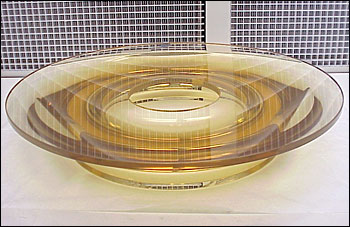
HiRise Returns Mega Terabits
MARS, June 21, 2007 -- Onboard NASA’s Mars Reconnaissance Orbiter (MRO), the HiRISE camera offers unprecedented image quality, providing a view of the Red Planet in a way never before seen, said the HiRise Operations Center at the University of Arizona (UA).
The most powerful camera ever to leave Earth’s orbit, the HiRise (high-resolution imaging science experiment) is more than six months into its science-gathering phase; the orbiter has already returned 11 terabits of data -- enough to fill over 2000 CDs. The total goal for the mission lifetime is 34 terabits. Alfred McEwen, a professor of planetary geology at UA in its Lunar and Planetary Laboratory and director of its Planetary Image Research Laboratory , is the principal investigator for HiRISE. 
Layers exposed in crater near Mawrth Vallis PSP_004052_2045, acquired June 6, 2007. Just 20 miles to the east of this crater lies Mawrth Vallis, an ancient outflow channel that may have been carved by catastrophic floods. The orbiting spectrometers OMEGA (on Mars Express) and CRISM (on MRO) have detected clay minerals in layered deposits in and around Mawrth Vallis. These minerals, which require water to form, are likely present in the layered bedrock exposed in this crater wall. The crater may thus provide a glimpse into an intriguing period of Martian history, when liquid water may have been more abundant at or near the Martian surface than it is today. (Photo: NASA/JPL/University of Arizona)
Among the impressive data are images from the orbiter's compact reconnaissance imaging spectrometer for Mars (CRISM) instrument. With CRISM, the NASA science team intends to investigate the entire planet in spectral mode at a resolution of 200 meters (656 feet) per pixel. The instrument has already logged data for 50 percent of it.
"CRISM has revealed sites with very interesting mineralogy that we want to investigate more closely," said Deputy Project Scientist Sue Smrekar. "Images from these sites are helping us learn more about Mars' ancient climate and the role of water on the surface."
The Jet Propulsion Laboratory, a division of the California Institute of Technology in Pasadena, manages the Mars Reconnaissance Orbiter for NASA's Science Mission Directorate, Washington. Lockheed Martin Space Systems is the prime contractor for the project and built the spacecraft.

LightWorks Optics' mirror, made for the HiRise
The HiRISE camera was designed, assembled and tested at Ball Aerospace and Technology Corp. in Boulder, Co. Among other providers of HiRise technology and services was optical systems developer LightWorks Optics, of Tustin, Calif., which provided a 50-centimeter mirror to Ball Aserospace specifically for that application. "The results are self-evident," said Phil Eads, director of business development at LightWorks Optics. "Because of that contribution, the entire system works."
HiRISE operates in visible wavelengths, the same as human eyes, but with a telescopic lens that will produce images at resolutions never before seen in planetary exploration missions. These high-resolution images will enable scientists to resolve 1-meter (about 3-ft) sized objects on Mars and to study the morphology (surface structure) in a much more comprehensive manner than ever before.
The camera also makes observations at near-infrared wavelengths to obtain information on the mineral groups present. From an altitude varying between 200-400 kms (about 125 to 250 miles) above Mars, HiRISE will return surface images that contain individual basketball-sized pixel elements (30-60 centimeters, or 1- to 2-ft wide), allowing surface features 4 to 8 ft across to be resolved. These new, high-resolution images will provide unprecedented views of layered materials, gullies, channels and other science targets and will characterize possible future landing sites.
For more information, visit: hirise.lpl.arizona.edu/
/Buyers_Guide/II-VI_Aerospace_Defense/c8571